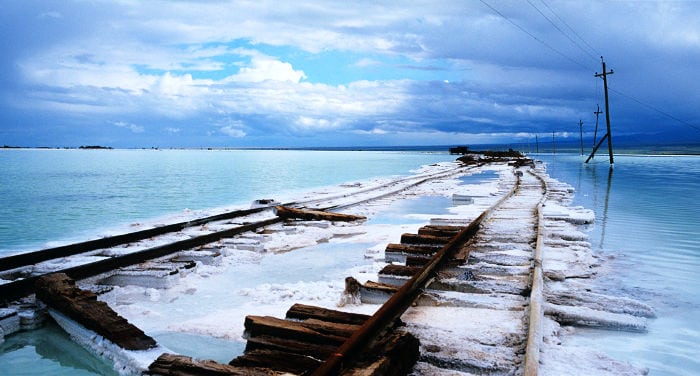
This article is a practical travel guide for visiting the Qinghai province, one of the most interesting provinces in China due to its natural beauty and cultural diversity. In it, you will find:
The information in this article comes from personal experience and sources that are mainly written in Chinese. Despite this, it may contain errors due to the fact that the information available tends to be hard to come by and is often contradictory (especially when it comes to transportation).
Basic information on the Qinghai province
Qinghai is located in the northeastern region of the country and is one of the least populated provinces (after Macao and Tibet), despite being the fourth largest in the country. The majority of Qinghai is located on the Tibetan plateau and is surrounded by the provinces of Xinjiang, Tíbet, Sichuan and Gansu.
After Xinjiang, Qinghai is the province with the largest population that does not belong to the Han ethnicity. The 36 ethnic minorities in Qinghai make up almost half of its population, and the largest of these are Tibetans, the Hui, the Tu, the Mongols and the Salar.
Historically, Qinghai has been quite a conflictive area, where different ethnic groups have attempted to establish control over the trade routes connecting eastern China with Central Asia and Tibet. Over its history, the domination of the area has alternated between Tibetans, the Han, the Mongols, and the Hui and Salar Muslim ethnicities. In fact, before the establishment of the People’s Republic of China, Qinghai was governed for more than 30 years by various Muslim-ethnicity generals responsible for the uprising against the Qing Dynasty and the defense against the Tibetan invasion.
Last of all, you should keep in mind that apart from the cities of Xining, Haidong and Golmud, the remainder of the territory is only occupied by small, relatively isolated towns.
Reasons to visit Qinghai
Qinghai is one of the most remote areas in China, which has allowed its ethnic minorities to better maintain their identity faced with Han conformist pressure, in addition to preserving its natural beauty.
Despite the fact that tourism has grown significantly over the past years, the province has not been massified and it is still possible to enjoy the natural riches and original culture without too much interference from the tourism industry, which tends to happen in many parts of the country.
Another benefit of the province is the possibility of getting to know Tibetan culture and the plateau without needing to request special permits, as is the case in Tibet and certain areas of Sichuan.
Last of all, Qinghai Lake may be one of the most spectacular natural environments in China. It’s a humongous salt lake (the largest in China) located at more than 3,000 m altitude.
When to visit Qinghai
Qinghai’s climate is very harsh in the winter, with temperatures that can go as low as -20°C and -30°C during the night in many areas. Between April and October, temperatures are tolerable, although they can drop significantly during the night (around 0°C). In addition, between February and April, strong winds and sandstorms are common.
The best time to visit Qinghai is during the summer (from June to August) when temperatures are pleasant during the day and cool during the night. Without a doubt, Qinghai is an ideal place to escape from the suffocating summer temperatures in the majority of the main Chinese cities.
Places to visit in Qinghai
Qinghai is a huge province with numerous places to visit. In this section, I will give the details on some of the most famous of them:
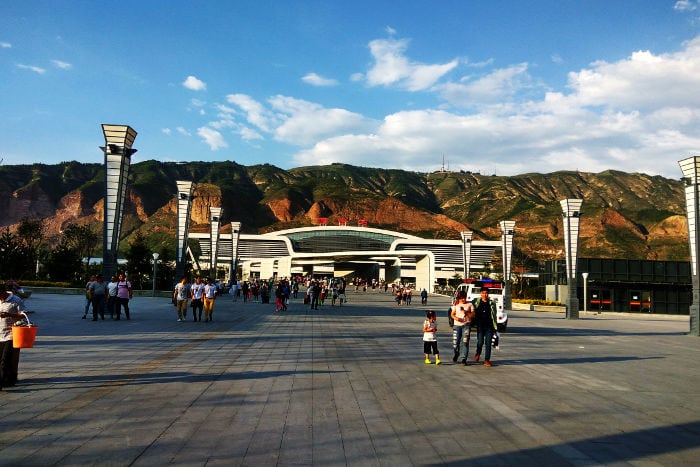 Xining Train Station
Xining Train Station
Xining (西宁)
Xining is the capital of the Qinghai province, and with more than two million inhabitants, it is the largest city on the Tibetan plateau. Historically, Xining has been an important trade center and essential military spot on the Northern Silk Road. Currently, Xining continues to be a very important transportation center, and it is the first station of the mythical Qinghai-Tibet railroad, which allowed to connect the Autonomous region of Tibet with the remainder of China.
Xining is also an important religious center for both Muslims and Buddhists, because of which the
Dongguan Mosque and the Ta’er Temple stand out.
Despite all of this, as a city, Xining isn’t particularly interesting for tourists, as it’s a modern city that isn’t very different from other Chinese centers.
How to get there
Xining is very well connected with the remainder of the country by both train and airplane.
- Plane: El Xining Caojiabao Airport is located 30 km from the city’s downtown and receives daily flights from the main Chinese cities, and even some international flights, such as from Bangkok.
- Train: Xining railway station is an enormous station that connects the provinces of Qinghai, Xinjiang and Tibet with the rest of the country. You can get to Xining on K-class trains from the main Chinese cities, such as Beijing, Shanghai or Xi’an. In addition, there currently exists a high-speed train line that connects Xining with Lanzhou (the capital of Gansu) in only one hour.
Where to stay
Xining does not have very many hotels where foreigners can stay, and has almost no hostels.
My recommendation is to stay near the Dongguang Mosque, as it is easy to access from the train station, offers interesting food (especially roast lamb and hot pot) and is one of the best places in China to observe the daily life of the Hui ethnic minority.
Click here to see the list of hotels available in Xining
What to visit:
The Kumbum monastery or Ta’er Temple (塔尔寺)
: At almost 400 years old, the Ta’er Temple is one of the most important Tibetan temples in China and is classified as an AAAAA National Tourist Attraction. The temple is located approximately 30 km from Xining and it takes between 30 minutes and an hour to get there.There are buses that connect Xining with the Ta’er Temple which leave every half an hour and take an hour to get there; however, it’s recommendable to rent a private vehicle to go there (around 250 Yuan per trip). The problem with the buses is that while it’s not hard to get there, it’s very difficult to come back. All of the buses that stop at the temple heading towards Xining are full. A solution is to get on the buses that arrive at the temple from the city of Xining and to do a loop around the city of Huangzhong (湟中, the city beside the temple). If you do decide to go by bus in the end, ask the hotel where to take the bus, as it seems that the place where it leaves from changes every once in a while.Hours of operation: from 8:00 to 17:00
Price of entry: 80 Yuan
- Dongguan Mosque (东关清真寺): Located in the Dongguan district, this mosque is the largest in Qinghai and one of the most important mosques in China. Despite being more than 600 years old, the constant renovations that it has undergone over the past years make it no longer appear to be a historic building. Even so, it’s interesting to see the mixture between typical Chinese and Muslim architecture.Hours of operation: from 9:00 to 17:00
Price of entry: 20 Yuan
- Other places of interest: the Tulou Temple (土楼观), Qinghai Provincial Museum (青海省博物馆), Qinghai-Tibet Plateu Wildlife Zoo (青藏高原野生动物园).
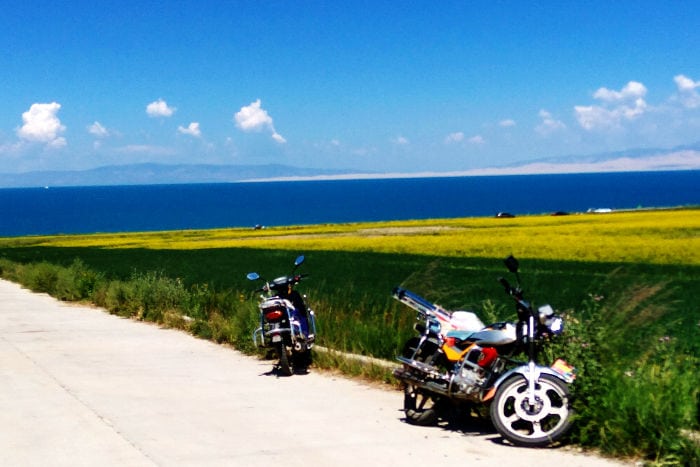 Lake Qinghai near Erlangjian
Lake Qinghai near Erlangjian
Qinghai Lake (青海湖)
Qinghai Lake is the largest lake in China and is an emblematic place for Mongol and Tibetan ethnic minorities, as can be seen in the songs of the famous Mongol-ethnicity band HAYA (哈雅乐团).
Below, we give details on some of the places that you can visit at Qinghai Lake:
Riyue Mountain (日月山)
Sun and Moon Mountain (Riyue Mountain) is not located right on Qinghai Lake in the strict sense, but the majority of the tourism buses heading that way will also stop there, as it is halfway between Xining and the lake. The mountain is a famous tourist attraction, given that it appears in classic Chinese literature. It’s a pretty place, but it’s not worth spending too much time there.
- Price of entry: 25 Yuan
Erlangjian Scenic Spot (二郎剑景区)
Erlangjian Scenic Spot is a tourism complex on the banks of Qinghai Lake but it isn’t worthwhile entering the facilities. It’s a lot better to rent a bicycle and explore the surrounding area, which is filled with yellow canola flowers in the summer.
In this area, all of the paths to access the lake are private, and because of this, you will have to pay the not-very-friendly Tibetans that watch over the way (you should bargain down the price). At the lake, you will be able to ride yaks to take a photo (you have to pay).
If you have time, it’s recommendable to spend the night in the area, as the return trip from Xining can be a bit heavy. There are numerous places to stay, including the possibility of spending the night in a Tibetan yurt.
- How to get there: From Bayilu bus station (八一路客运站), buses leave every day (in high season) at 7:30, 8:00, 8:15, 8:30, 8:45, 9:00, 9:15, 9:30 and 16:00. The bus takes around 2 ½ hours (if there’s no traffic) and costs 40 Yuan.
- Price of entry: 100 Yuan (50 Yuan during low season)
Bird Island (鸟岛)
Located in the northeastern part of the lake, Bird Island is a very beautiful natural area that’s perfect for observing the huge diversity of migratory birds in the area.
- Price of entry: 115 Yuan (75 Yuan during low season)
- Hours of operation: From 8:30 to 17:30
- How to get there: The island is located 300 km from Xining and tours will take you there for around 130 Yuan per person (they leave at 7:00 and you come back at 22:00). A private vehicle costs around 1,200 Yuan for a return trip.
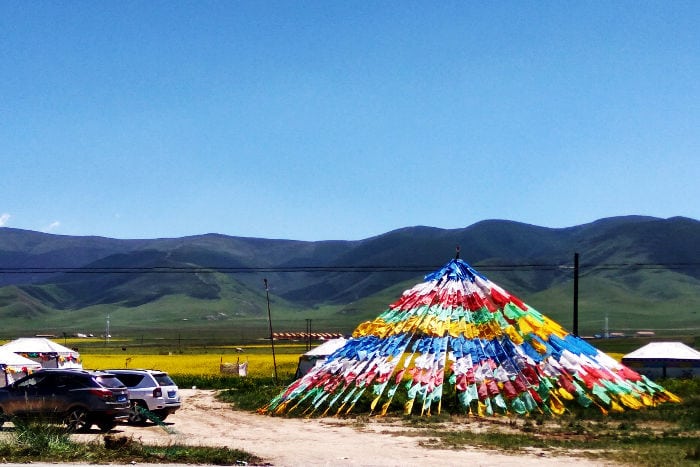 Tourist accommodations in Tibetan yurts
Tourist accommodations in Tibetan yurts
Heimahe (黑马何乡)
Located 220 km from Xining, Heimahe or Black Horse River is located halfway between Xining and Bird Island. In addition, it’s a good place to spend the night and see the sunrise at Qinghai Lake. People consider the region of the lake between this town and Bird Island to be the prettiest. In addition, it’s relatively close to Chaka Lake.
It’s a tourist area, so it won’t be difficult to find lodging, although there can be some problems in providing accommodations for foreigners.
- How to get there: The tourism buses heading in the direction of Qinghai Lake that leave from Xining Bus Station (西宁汽车站) stop in Heimahe and cost around 45 Yuan. The first bus leaves at 8:00 and takes around three hours.
Chaka Salt Lake (茶卡盐湖)
Lake Chaka is located approximately 300 km from Xining in the Haixi Mongol and Tibetan Autonomous Prefecture. The lake receives its name from a small town located 9 km from it which was an important location on the former Silk Road.
Chaka Salt Lake is undoubtedly one of the most beautiful natural areas in Qinghai. Located at 3,000 m altitude, it’s a lake of naturally crystallized salt that constitutes one of the largest and oldest salt mines on the planet (it has been being exploited for 3,000 years).
How to get there:
There are three options to get to the lake from Xining:
- Take the bus that leaves every day at 12:00 from the Xininglu bus stop (新宁路汽车站). The ticket costs 60 Yuan and takes 5 hours.
- From Xininglu as well, it’s also possible to take one of the many buses that head to the county of Ulan (乌兰县) and which stop in the town of Chaka, where you can take private transportation to reach the lake. The bus takes 6 hours and costs around 70 Yuan.
- Take the tourist train that leaves from Xining Railway Station (Y961/2). There is only one train per day during high season (June, July, August). It takes four hours and leaves at 8:25, and the train back leaves at 17:00. Each ticket costs 62.5 Yuan and must be booked at least 2-3 days in advance.
It’s important that you make sure that entry to the lake is permitted before going, as in the past, it has been closed to the public due to the damage caused by tourism pressure.
In Chaka, there are no places that can legally provide lodging to foreigners. The closest place to stay is in the city of Ulan 80 km away. However, you might be to find lodging in Heimahe, which is closer.
The lake offers spectacular views and can be traveled on foot or via the tourist train (a former merchandise train). In addition, you’ll be able to view giant sculptures made of salt and the particular salt flowers. Don’t forget to bring sunglasses, as the potent reflection of the Qinghai sun can be particularly damaging.
Entry: Entry to the lake costs 70 Yuan and the tourist train costs 50 Yuan. Hours of operation are from 7:00 to 18:30.
Zhuo’er Mountain (卓尔山)
Also known as the Switzerland of the East, Mount Zhuo’er offers spectacular views of the plains of the Tibetan plateau. The natural reserve is located approximately 300 km to the northeast of Xining.
How to get there: There are 6 buses daily that leave from the bus station of the tourist downtown of Xining (旅游集散中心) and which head in the direction of the Qilian district (08:15, 09:15, 10:15, 11:15, 12:30, 14:30).
Entry: Entry costs 60 Yuan in high season and 30 Yuan in low season.
Kanbula National Forest Park (坎布拉国家森林公园)
Located approximately 200 km from Xining, this national park is famous for its red colored rock formations and abundant forests. It is also worth highlighting the Buddhist temple located at the peak of one of its mountains and the numerous caves with Buddhist statues within them.
How to get there: Take the bus in the direction of the city of Kanbula (坎布拉镇) at the long-distance bus station in Xining (长途汽车).
Entry: 50 Yuan, from 8:00 to 18:00
Other places
Source of Three Rivers or Sanjiangyuan Nature Reserve (三江源国家级自然保护区)
This nature park is where the three large Asian rivers of the Yellow River, the Yangtze River and the Mekong River are born. In addition, it’s one of the largest natural reserves in China and is the one that has the largest concentration of alpine animals.
Menyuan Rape Flower Scenic Spot (门源油菜花): If you are a fan of fields of yellow canola flowers, this is the best place to observe them.
Tongren (同仁): This is a small, majority-Tibetan city that’s famous for its temples and is a good place to go hiking.
Golmud (格尔木): This is the second largest city in the province and the last important stop on the railway that connects China to Lhasa. Golmund is famous due to the fact that it’s surrounded by 20 salt lakes and is a city whose economy is based on mining. On July 25, the famous Horse Festival is held.
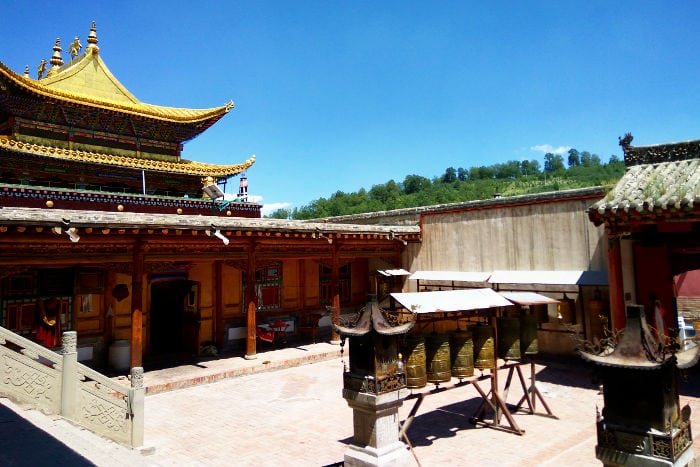 One of the pavilions of the Ta’er Temple in Xining
One of the pavilions of the Ta’er Temple in Xining
Suggestions for visiting Qinghai
- Organizing your trip: Even though as opposed to Tibet, it’s not necessary to take a tour to visit Qinghai, it’s very complicated to organize the trip yourself, so it’s a good idea to hire a tour with an agency that knows the area well. You can click here and we will recommend a trustworthy agency to you.
- Altitude sickness: Qinghai is located on the Tibetan plateau and across the majority of the province, the altitude is greater than 3,000 m. It’s important to give your body time to get used to the altitude. If you get symptoms such as a constant headache, lack of appetite, fatigue or insomnia, it’s a good idea to not continue to go to higher altitudes, to drink a lot of water and to avoid alcoholic beverages.
- Sun protection:
Due to its altitude, solar radiation in Qinghai is very strong. In addition, the wind and relatively low temperatures will make it so that you don’t realize the intensity of the solar radiation. Nonetheless, be careful and apply sunscreen on all of your exposed skin to avoid burns.
- Transportation: The public transportation in the area is somewhat lacking, and while you can reach all of the places of interest, it’s recommendable to rent a vehicle, whether with a driver or not. Having a private vehicle will give you a lot more freedom to explore the province.
- Infrastructure: Even though networking in the province has improved greatly over the past years, the increase in tourism has been quicker, which means that in summer, there are often traffic jams and travel time has been increasing greatly. During other times of year, despite less tourism, climactic conditions tend to result in delays. Make sure that you plan your trip with relatively flexible times, as delays can be frequent.
- Cultural aspects: Qinghai was a very isolated area until just recently, because of which its ethnic minorities have been able to maintain their customs almost unchanged. Over the past years, thanks to the rise of tourism, the population has become somewhat more tolerant, but you have to continue to be careful to not offend their religious beliefs, such as by ordering or drinking alcohol in a restaurant run by Hui Chinese.
- Be careful around Tibetan dogs: If you decide to go for a walk in rural areas of Qinghai, you might run into dogs belonging to the nomadic populations in the area. Tibetan-breed dogs have been selected as guard dogs, because of which they tend to attack people they don’t know. If you are unlucky enough to run into one, keep your calm and if it moves closer to you, drive it back with a stick, belt, or whatever you have in your hand. Under no circumstances should you run away.
That’s all for today. I hope that you find this guide to be useful, and if you have any questions or suggestions, don’t hesitate to leave a comment.
Cover Photo Credits: ![]() Caka Salt Lake/Qinghai Province/青海.察卡盐湖 by bomb_bao
Caka Salt Lake/Qinghai Province/青海.察卡盐湖 by bomb_bao



